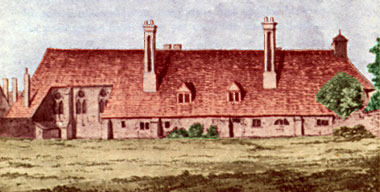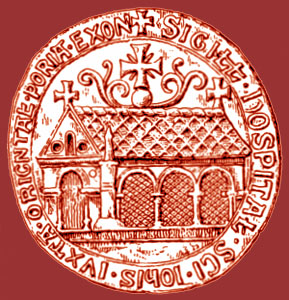
St. Mary's Hospital, Chichester
Drawing by S. H. Grimm; British Library, Add. Ms. Burrell
colourized by S. Alsford
St. Mary's is known to have been in existence by 1229 and was said to have been founded by the Dean of Chichester during the reign of Henry II; it appears to have had an early association with a church of the same dedication in Chichester's marketplace. It was refounded as an almshouse by a later dean, Thomas de Lichfeld in the 1230s or '40s and was better endowed, with properties in the town and surrounding region.
When refounded it provided permanent accommodations for 13 inmates, both male and female. At least some of these were sick and infirm persons, with preference given to those lacking friends or family who might otherwise have cared for them; if they recovered they were allowed to leave, taking with them whatever clothing and money they had upon arrival. Others were possibly chosen because deserving (in terms of character and poverty), but healthy enough to perform domestic services. The hospital's master had final say over admissions. Permanent inmates were required to take vows of obedience, chastity and poverty, and their hair was cut short in a monastic style; infringing hospital regulations was typically punished by the offender sitting at the end of the table at meals, fed only with bread and water, without a napkin. Overnight accommodations were offered to poor persons.
In 1269 the hospital obtained permission from the king to relocate to the former house of the Friars Minor, who themselves had moved to the site of the destroyed castle in Chichester. The actual move may not have taken place until the 1280s. This building is what is shown in the above illustration. The chapel is clearly visible at the left end; the remainder of the building was a hall (84 feet long) serving as the infirmary. The hospital was entered through a courtyard, whose wall is just visible at the right-hand side of the illustration. The chimney-stacks are post-medieval.
A century later, things had gone downhill at the hospital, necessitating an enquiry into a drop in the number of inmates, mismanagement of its property, and decay of the building and its furnishings. In 1402, an episcopal visitation found that religious services were neglected and the poor inmates were being defrauded of their allowances of food and pocket-money. By 1478 the hospital had only 5 inmates, and this was officially defined as the limit in 1528. For information on other hospitals at Chichester, see the document in the Politics section, "Suppression of alleged borough liberties and self-government".

Seal of the Hospital of St. John, Exeter
Drawing by J. Charles Wall
The original dedication was to St. John Baptist. Judging from the depiction on the seal, which shows one side and what appears to be the west front with an entrance, the architecture was church-like. The hospital was under the guardianship of the Bishop of Exeter from 1244, but later under the jurisdiction of the city authorities.